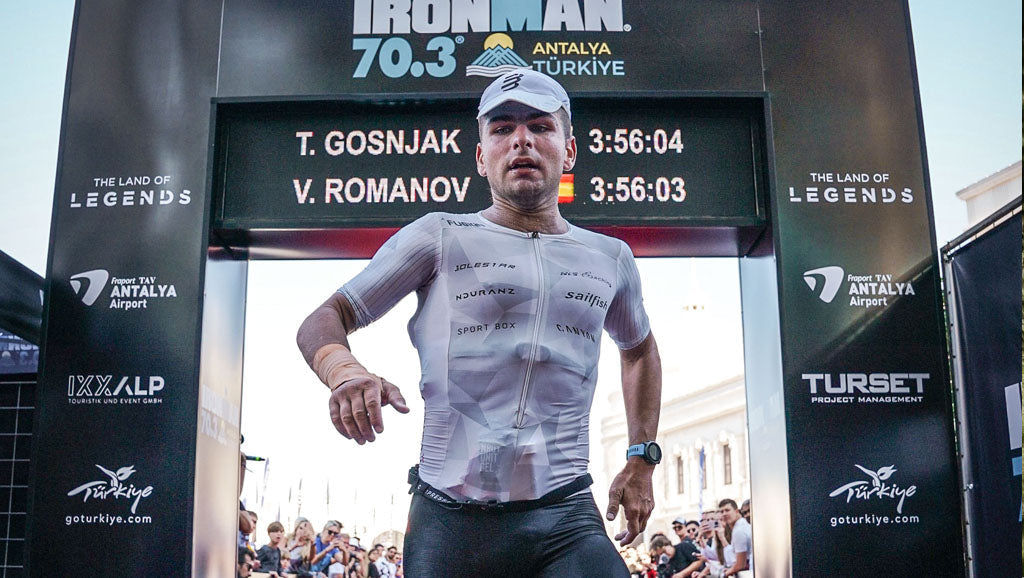Fueling for a triathlon isn’t something you ramp up on race day—it’s a strategy you build and refine long before you pick up your bib number. From carb loading leading up to the event to fueling at the right time during each segment, every choice you make has a direct impact on your performance.
This guide walks you through the key aspects of the plan so your body has what it needs to carry you to the end.
The Weeks Before: Prioritize Recovery

In the weeks before the triathlon, you may be tempted to pile on more training sessions. But every ride, run, and swim causes micro-damage to your muscles and depletes energy stores. If you push too hard without proper recovery, you risk fatigue, injury, or underperformance on race day.
Focus on quality over quantity: allow for rest days, include lighter recovery workouts, and prioritize sleep and nutrition. Now is not the time to forget your post-session recovery shake, and make sure you consume it within the 30-minute recovery window.
For more, read our Guide to Recovery.
Days Before: Load and Prepare
The days before a triathlon race are all about topping off your muscle glycogen stores and preparing your gut. This means carb loading with simple carbohydrates and avoiding fiber, as it can linger in the gut and cause digestive issues during the race.
Guidelines:
- Start loading 24–36 hours before the race. There is no need for a longer loading protocol.
- Aim for 8–12 g carbohydrates per kg of body weight per day, focusing on fast-digesting carbs like rice, pasta, and bread.
- Reduce fiber intake in the 24 hours before the race.
Learn more in our Guide to Carb Loading.
Pre-Race Breakfast

Assuming you followed a proper carb loading protocol, your muscle glycogen levels will be topped off on race-day morning. However, your body uses liver glycogen to fuel organs even while you sleep, so these levels will be low. That’s why it’s important to have a proper breakfast before the race starts.
Ideally, you should eat a breakfast of simple carbohydrates several hours before your start. This gives you plenty of time to digest the food. If you have an early start time, though, this may not be practical. In this case, your adjust your carbohydrate amounts based on how much time you have.
Guidelines:
- Breakfast should consist of simple carbohydrates with no/low fat and fiber.
- Consume breakfast 2-4 hours before start time.
- For early starts, consume 1 g fast carbohydrates per kg of body weight per hour before the start time (Ex. If only one hour before start, a 65 kg triathlete would consume 65 g of carbohydrates for breakfast).
See our favorite Race-Day Breakfast Ideas.
Pro Tip: Have your breakfast prepared or planned the day before. Hotel buffets may not open early enough, so pack simple foods like bagels, rice cakes, or sports drinks.
Swim Segment

While it is theoretically possible to consume fuel while swimming (back bottles, gels tucked into your tri suit…), it’s virtually impossible to do it without stopping or slowing yourself down. Fortunately, the swim segment is short. Even on a full Ironman, the swim segment rarely lasts much more than 1 hour. Your body will have enough glycogen stored to get you through without additional fuel.
This doesn’t mean you should skip fueling though. If you don’t consume some fuel before the swim segment, your glycogen levels may be low when you get to the bike segment.
Guidelines:
- Consume fuel approximately 15 minutes before the start.
- Aim for 20–45 grams of fast carbohydrates.
- Stick to gels or liquid fuels. Avoid solids.
- Don’t overdo fueling: your digestion is still “warming up.”
Pro Tip: Stash a gel in your tri suit as a backup. If you end up having a delayed start, you’ll be glad you can take it immediately when you get out of the water.
Cycling Segment

The cycling segment is where you will really ramp up fueling during the triathlon. This fuel helps you restore glycogen levels from the swim segment, and also provides energy for the bike running segment.
Your body is relatively stable on the bike, with your stomach getting jostled less, so it is okay to consume some fast-digesting solid fuels during this segment. However, gels and energy drinks are still the most popular option as they are the easiest to digest.
If using energy drinks, save time by preloading bottles with energy drink mix. Then you can just dump water in them from aid stations.
Guidelines:
- Consume 90 g of carbohydrates per hour for Half-Ironman and Full Ironman distances.
- For Olympic races, aim for 60 to 90 g per hour.
- Use a mix of energy gels, energy drinks, and solid fuels.
- Hydrate consistently. Target 500–750 ml of fluids per hour, adjusted for heat and sweat rate.
- Include electrolytes (especially sodium) to support hydration.
- Avoid overhydrating as it can cause discomfort during the run segment.
Pro Tip: Don’t try any new fuels on race day. If the triathlon provides fuel at aid stations: only take it if you’ve trained with it.
Running Segment

The run is the hardest segment to fuel in a triathlon. The pounding motion jostles your stomach, making it harder to digest. Depending on the triathlon length, the temperature may also be warmer than when you started. Heat stresses the body, and digestion is even harder.
You won't run with a bottle—which means gels are your best fueling option for this segment. But gels need to be taken with water for maximum absorption, and can leave a sugary taste in your mouth. That means you’ll need to time your gel consumption around aid stations so you have water to wash it down.
Guidelines:
- Consume 60–90 g of carbohydrates per hour for Half-Ironman and Full Ironman distances.
- Use energy gels and wash down with water from aid stations. Avoid solids.
- Hydrate consistently. Target 250–750 ml of fluids per hour, adjusted for heat and sweat rate.
Do you need to fuel a sprint triathlon?
No, fueling is not necessary during a sprint triathlon. These triathlons are usually completed within 1.5 hours, so your body’s stored glycogen is enough. However, mouth rinsing—the act of swishing a carbohydrate drink in your mouth and spitting it out—can be beneficial. It tricks the brain into thinking that fuel is coming.

At the Finish Line
Regardless of the triathlon distance, recovery is crucial. You need protein to help repair muscles, carbohydrates to restore glycogen, and sodium to replace what you lost through sweat. The recovery window is only 30 minutes, so you need to consume your recovery nutrition within this short timeframe.
To keep things simple and ensure recovery isn’t delayed, Dr. Tim Podlogar recommends using the same recovery drink after each session or race. You can then adjust nutrition later in the day, such as by adjusting the size of your dinner to stay in energy balance.
General Fueling Tips for Triathletes
- Practice your fueling in training. Your gut can be trained just like your muscles.
- Dial in transitions. Keep a gel taped to your bike for a quick start to the cycling leg.
- Plan backups. Races are unpredictable—have an extra gel or two in case you drop one or an aid station is crowded.
- Stay flexible. Hot, humid races demand more fluid and sodium. Cooler races require less.
- Don’t chase someone else’s plan. Test, adjust, and build a strategy that works for you.

